The Gabar Goshawk (Micronisus gabar) emerges as a charismatic and formidable bird of prey, enchanting observers with its compact stature and remarkable aerial prowess.
Native to sub-Saharan Africa, this raptor navigates a diverse range of habitats, from the highlands of Ethiopia to the woodlands of South Africa.
Distinguished by sexual dimorphism, the males exhibit a striking slate-grey upper body, while females don a camouflaged brown plumage with intricate streaks.
Known for their agile and acrobatic flight patterns, Gabar Goshawks are skilled hunters, preying on small birds, mammals, and insects with precision.
The intricacies of their nesting behaviors, vocalizations, and cooperative parenting strategies further unveil the captivating life history of these birds.
Amidst their expansive geographical range, the Gabar Goshawk stands as a testament to adaptability, thriving in the diverse landscapes that define the African continent. So, stay focused.
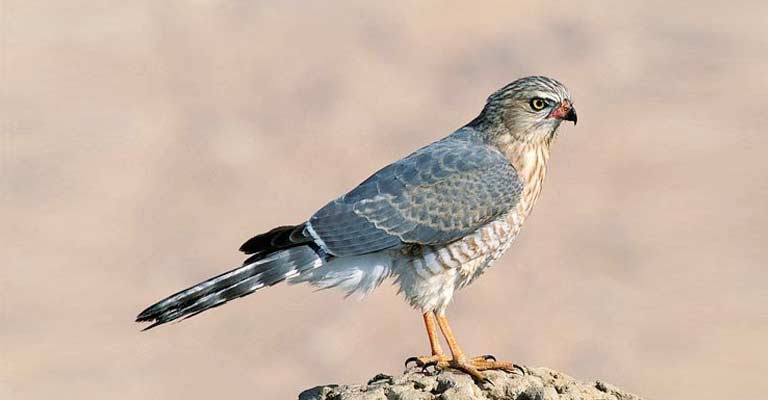
Identifying Characteristics of Gabar Goshawk
The Gabar Goshawk (Micronisus gabar) is a small but striking bird of prey that inhabits the savannas and woodland areas of sub-Saharan Africa.
Identifying this specific bird requires a keen eye and attention to various distinguishing characteristics. Here are some key points to help you identify the Gabar Goshawk:
Size and Shape
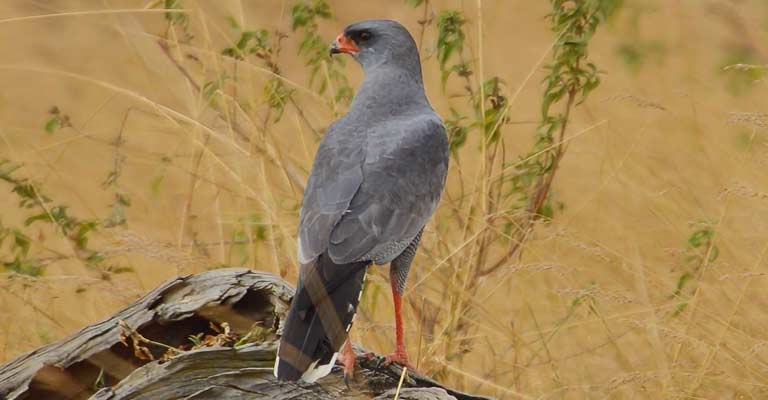
The Gabar Goshawk is a relatively small raptor with a compact and agile build. It typically measures around 30 to 35 centimeters in length.
Its wings are relatively short and rounded, giving it a distinctive shape in flight. The tail is long, with a squared-off tip.
Coloration
Adult Gabar Goshawks exhibit sexual dimorphism in their plumage. Males generally have a striking slate-grey upper body with a white underbelly and finely barred chest.
The females, on the other hand, are brown above with a streaked or spotted pattern and a buff-colored underbelly. Juveniles resemble females but tend to be more heavily marked.
Facial Features
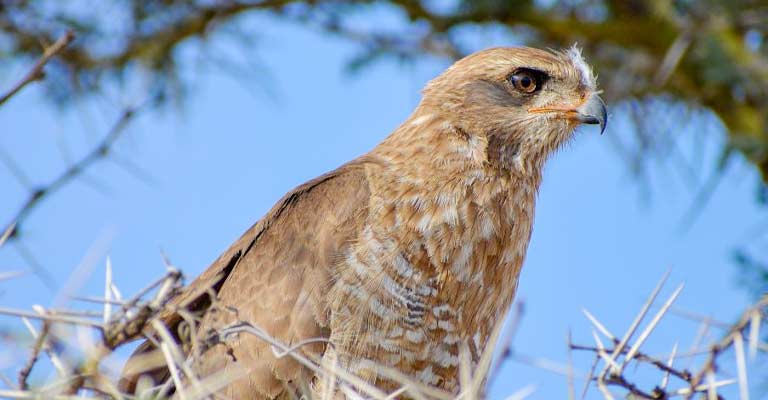
The face of the Gabar Goshawk is characterized by bright yellow-orange eyes.
This eye color stands out against the contrasting dark facial mask that extends from the eyes to the nape of the neck. The hooked beak is dark and powerful, adapted for tearing into prey.
Flight Pattern
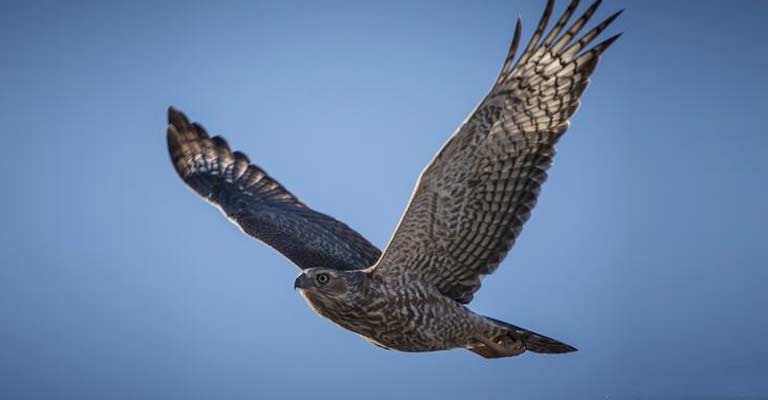
When in flight, the Gabar Goshawk displays a distinctive flap-and-glide pattern. The rounded wings and short tail contribute to its agile flight.
Look for this bird flying low over the landscape or perched in a prominent position, scanning the surroundings for prey.
Habitat Preferences
Gabar Goshawks are commonly found in open woodland, savannas, and scrublands.
They are adaptable birds, able to thrive in a variety of landscapes. Observing their habitat preferences can be a crucial clue when identifying them.
Call and Vocalization
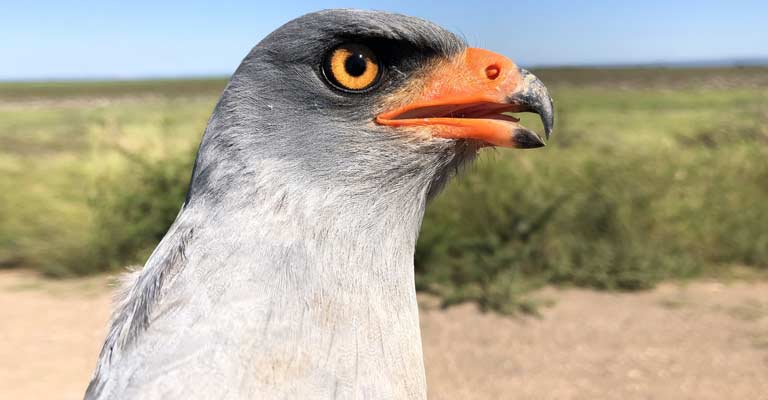
The Gabar Goshawk has a distinctive, high-pitched call. It’s often described as a sharp “kee-kee-kee” or “kleeek-kleeek.” Learning to recognize their vocalizations can be a valuable aid in identifying these raptors.
Hunting Behavior
Watch for their hunting behavior. Gabar Goshawks are known for their skillful and agile hunting techniques.
They often hunt from a perch, swooping down to catch small birds, mammals, and insects. Their swift and precise movements are indicative of their predatory nature.
Geographical Range
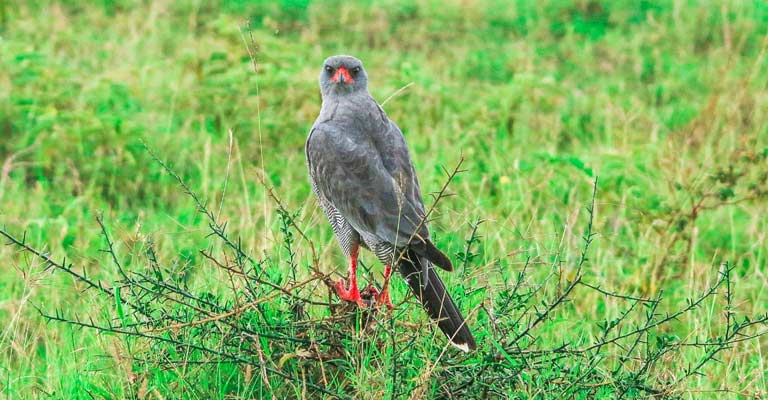
Understanding the geographical range of the Gabar Goshawk is essential for identification.
These birds are native to sub-Saharan Africa, including countries such as Senegal, Sudan, and South Africa.
Confirming the presence of the bird within its expected range can be a key factor in identification.
Identifying the Gabar Goshawk requires a combination of visual and behavioral cues.
Paying attention to size, coloration, facial features, flight patterns, habitat, vocalizations, hunting behavior, and geographical range will enhance your ability to recognize this captivating bird of prey in the wild.
Taxonomy of Gabar Goshawk
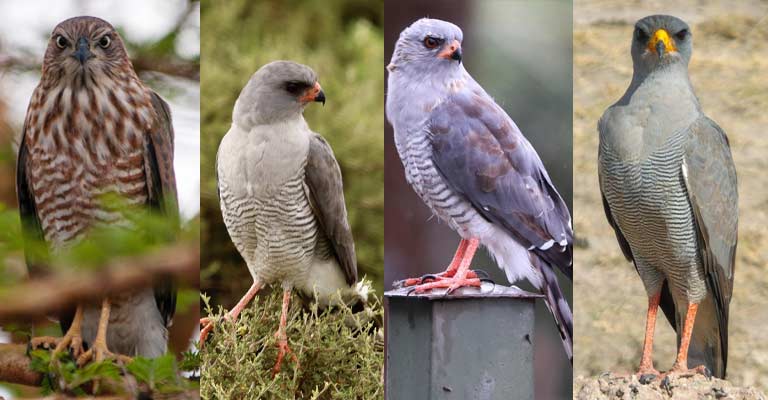
Here is a table outlining the taxonomical details of the Gabar Goshawk:
| Taxonomic Level | Classification |
| Domain | Eukaryota |
| Kingdom | Animalia |
| Phylum | Chordata |
| Class | Aves |
| Order | Accipitriformes |
| Family | Accipitridae |
| Genus | Micronisus |
| Species | M. gabar |
The Gabar Goshawk (Micronisus gabar) exhibits a fascinating diversity through its recognized subspecies, each adapted to specific regions within sub-Saharan Africa.
These subspecies showcase distinct geographic ranges and variations in plumage, contributing to the intricate tapestry of avian biodiversity:
- M. g. aequatorius: Found in the highlands of Ethiopia to the Democratic Republic of the Congo, Zambia, and northern Mozambique, M. g. aequatorius inhabits elevated landscapes. This subspecies displays unique adaptations to the cooler climates and varied terrain of the Ethiopian Highlands and surrounding regions.
- M. g. gabar: Inhabiting southern Angola to Zambia, Mozambique, and South Africa, M. g. gabar occupies a diverse range of habitats, from savannas to woodlands. This subspecies reflects adaptations to the varied ecosystems of southern Africa, showcasing the adaptability of the Gabar Goshawk to different environmental conditions.
- M. g. niger: Extending from Senegambia to Sudan, northern Ethiopia, and southwestern Arabia, M. g. niger is distributed across a vast area. This subspecies reflects adaptations to both the arid landscapes of southwestern Arabia and the diverse ecosystems of northeastern Africa, showcasing the Gabar Goshawk’s ability to thrive in contrasting environments.
Understanding the distinctions among these subspecies not only enriches our knowledge of Gabar Goshawk biodiversity but also underscores the importance of regional conservation efforts tailored to the specific needs of each population.
Gabar Goshawk Life History
The Gabar Goshawk (Micronisus gabar) unfolds a fascinating life history, providing insights into its adaptations, behaviors, and challenges.
This small but formidable raptor is distributed across sub-Saharan Africa, where it navigates diverse habitats and faces various ecological pressures.
In this exploration of the Gabar Goshawk’s life history, we delve into its dietary preferences, nesting and breeding behaviors, susceptibility to diseases, potential treatments, and the importance of conservation efforts.
Food
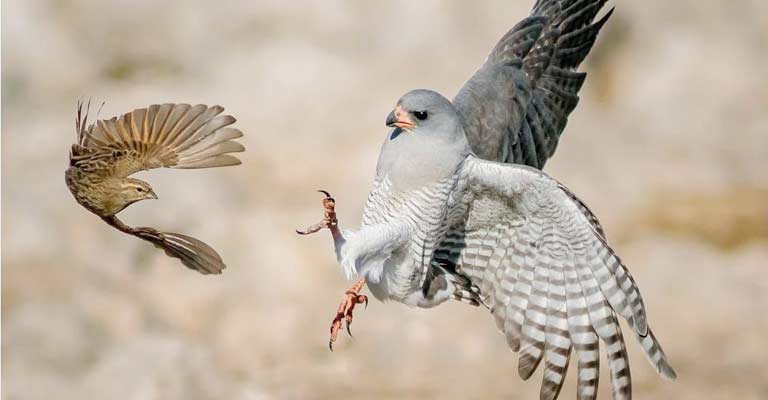
The Gabar Goshawk is a carnivorous bird of prey with a diverse diet. Its primary food sources include small birds, mammals, and insects.
These raptors are adept hunters, employing swift and precise aerial maneuvers to capture prey.
Known for their agility, they often hunt from perches or in flight, relying on sharp talons and a powerful beak to subdue and consume their quarry.
Habitat
Adaptable to a range of environments, Gabar Goshawks are commonly found in open woodlands, savannas, and scrublands. Their ability to thrive in diverse habitats underscores their resilience and flexibility.
The availability of suitable perching sites and an abundance of prey in these areas influences their habitat preferences.
Range Map
The Gabar Goshawk’s range extends across sub-Saharan Africa, covering a vast expanse from Senegal in West Africa to Sudan in the northeast and reaching as far south as South Africa.
Consulting a range map is invaluable for understanding the geographical distribution of these birds and their presence within specific regions.
Nesting and Breeding
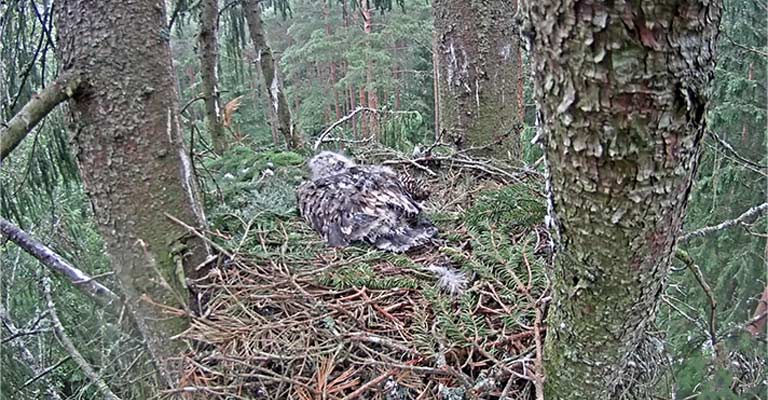
During the breeding season, Gabar Goshawks construct nests in trees, typically at a considerable height above the ground. The female is responsible for incubating the eggs, while the male provides food and protection.
The nesting period is a critical phase in their life cycle, and observing their nesting behaviors contributes to a comprehensive understanding of their reproductive strategies.
Here’s a table summarizing nesting details of the Gabar Goshawk:
| Nesting Details | Gabar Goshawk |
| Clutch Size | 2-4 eggs |
| Number of Broods | Usually 1 per year |
| Egg Length | Approximately 40 mm (1.6 inches) |
| Egg Width | Approximately 32 mm (1.3 inches) |
| Incubation Period | Around 30 days |
| Nestling Period | Approximately 40-45 days |
| Egg Description | Pale bluish-white with some faint spots and markings |
| Nest Location | Constructed high in trees, often on a horizontal branch |
| Nest Structure | Bowl-shaped, made of sticks, and lined with finer materials |
| Parental Care | Both parents contribute to the incubation and feeding of chicks |
| Fledgling Independence | Chicks become independent after leaving the nest, but parental care may continue for some time |
These nesting details provide insight into the reproductive biology and parental care behaviors of the Gabar Goshawk, highlighting their strategies for successful breeding and the subsequent care of their offspring.
Diseases
Like many bird species, Gabar Goshawks are susceptible to various diseases, including avian influenza and other infectious conditions.
Monitoring their health is crucial for the overall well-being of the population. In captivity, stress-related disorders and nutritional imbalances can also pose threats to their health.
Treatment
In cases where Gabar Goshawks are affected by diseases or health issues, prompt veterinary intervention is essential.
Treatment may involve medication, dietary adjustments, and measures to address environmental factors contributing to stress.
Captive breeding programs and conservation initiatives may incorporate health monitoring to ensure the long-term viability of the species.
Conservation
The conservation status of the Gabar Goshawk emphasizes the importance of protecting its natural habitats and addressing potential threats.
Deforestation, habitat degradation, and illegal trapping for the pet trade pose significant risks.
Conservation efforts involve habitat preservation, awareness campaigns, and research to better understand the ecological requirements of these raptors.
The life history of the Gabar Goshawk is a captivating narrative of adaptation, survival, and the delicate balance between the species and its environment.
By delving into their food preferences, habitat choices, range map, nesting and breeding behaviors, susceptibility to diseases, potential treatments, and conservation needs, we gain a holistic understanding of this remarkable bird’s existence in the diverse landscapes of sub-Saharan Africa.
10 Fun Facts About Gabar Goshawk
The Gabar Goshawk (Micronisus gabar) is a captivating bird of prey found in sub-Saharan Africa, and its unique characteristics make it a subject of fascination for bird enthusiasts.
Here are 10 fun facts about the Gabar Goshawk:
- Size and Agility: Despite its relatively small size, the Gabar Goshawk is known for its remarkable agility. With a length of around 30 to 35 centimeters, these raptors exhibit swift and acrobatic flight patterns, making them adept hunters in their varied habitats.
- Distinctive Plumage: The male Gabar Goshawk boasts a striking slate-grey upper body with a white underbelly, while the females exhibit a more camouflaged brown coloration with streaks and spots. This sexual dimorphism in plumage adds a fascinating visual aspect to their identification.
- Vocal Talents: Gabar Goshawks are not only skilled hunters but also vocal birds. Their high-pitched calls, often described as sharp “kee-kee-kee” or “kleeek-kleeek,” contribute to the auditory richness of the environments they inhabit.
- Habitat Adaptability: These raptors showcase remarkable adaptability to diverse habitats, ranging from open woodlands and savannas to scrublands. Their ability to thrive in different landscapes reflects their resilience and resourcefulness.
- Predatory Excellence: Gabar Goshawks are consummate predators, preying on small birds, mammals, and insects. Their hunting techniques involve swift aerial maneuvers, and they are known for hunting from perches or in flight with great precision.
- Nesting Strategies: During the breeding season, Gabar Goshawks construct nests high in trees, often on horizontal branches. The nests are bowl-shaped and made of sticks, providing a secure and elevated location for their eggs and chicks.
- Parental Roles: Both male and female Gabar Goshawks play active roles in parenting. The female incubates the eggs, while the male provides food and protection. This cooperative parenting strategy enhances the chances of successful reproduction.
- Egg Appearance: The eggs of Gabar Goshawks are pale bluish-white with some faint spots and markings. This unique egg appearance adds to the overall intrigue of their reproductive biology.
- Geographical Range: The Gabar Goshawk’s range spans a vast region of sub-Saharan Africa, encompassing countries like Senegal, Sudan, and South Africa. Their distribution contributes to the ecological diversity of the landscapes they inhabit.
- Conservation Concerns: While not currently classified as globally threatened, habitat loss and degradation pose potential threats to the Gabar Goshawk. Conservation efforts focused on preserving their natural habitats are crucial for the continued well-being of these fascinating birds.
The Gabar Goshawk is more than just a bird of prey; it is a testament to adaptability, skill, and the intricate interplay between these raptors and their environments in the diverse landscapes of sub-Saharan Africa.
Wrapping Up
The Gabar Goshawk emerges as a captivating avian species, showcasing agility, distinctive plumage, and remarkable adaptability in diverse African landscapes.
From their predatory excellence to cooperative parenting strategies, these raptors enrich the ecosystems they inhabit.
The Gabar Goshawk’s nesting behaviors and vocal talents add layers to its fascinating life history, underscoring the need for conservation efforts to ensure the continued thriving of this remarkable bird of prey. Thank you so much.